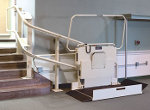The Wheelchair Guide
Your Wheelchair and Mobility Scooter Resource
Commercial Wheelchair Lifts
Tuesday, November 9th, 2010 at 10:21 am
 In the home, while building codes and inspections are required, there is generally a much more relaxed attitude towards the use of safety devices, such as wheelchair ramps or porch lifts, but in a commercial environment, there is a much stricter process of ensuring that these sorts of devices not only meet code, but also receive regular maintenance. For this reason, when someone wants to install a commercial wheelchair lift, there are a number of factors that must be considered.
In the home, while building codes and inspections are required, there is generally a much more relaxed attitude towards the use of safety devices, such as wheelchair ramps or porch lifts, but in a commercial environment, there is a much stricter process of ensuring that these sorts of devices not only meet code, but also receive regular maintenance. For this reason, when someone wants to install a commercial wheelchair lift, there are a number of factors that must be considered.
Porch lifts, which is a more colloquial term for vertical platform lifts, are in many ways very similar to an elevator. However, where an elevator requires a great deal of structure, namely the elevator shaft, a vertical platform lift is a single self contained unit. The main advantage of vertical platform lifts over elevators is that they can be placed next to a staircase, providing full access to the area, but with little actual modification to the existing structure of the building.
Meeting and Exceeding City Requirements
When considering installing a commercial wheelchair lift, however, the distinction between elevator and wheelchair lift is often a little less clear, as many cities and municipalities classify these devices as elevators, which must meet similar codes and requirements.
So, the first step for any business owner wishing to install a vertical platform lift, should always be to check city or county codes. A good place to start is to call up your local inspector, which is often located in town hall. If they do not know the codes that a wheelchair lift would fall under, they will be able to point you in the right direction. However, it is important to find and read the required code, with reference books often being available at the library.
A Word About Litigation, the ADA, and Basic Requirements
Making sure the wheelchair lift meets code is important not only for safety and inspection purposes, but also for reducing the risk of a lawsuit or injury. It is important to keep in mind that while in some cases, a vertical platform lift might bring a busi9ness up to code, such as if the business does not meet ADA standards and has no wheelchair ramp, it can also open the business owner up to litigation if there is an injury on the device or a malfunction.
There are several things that a business owner can do to mitigate these risks, such as using a commercially rated wheelchair lift that well exceeds the lifting requirements of the users. In addition to a larger lifting capacity, having a locking mechanism, so the wheelchair lift can only be operated by authorized personal is also very important.
It is also essential that a door is present at the top of the landing, so when the wheelchair lift is moving or at the bottom of the stairs, someone can not fall through the opening. Many commercial wheelchair lifts include a built in door, but it can also be added as an extension of the existing handrail.